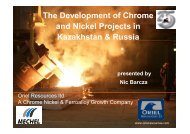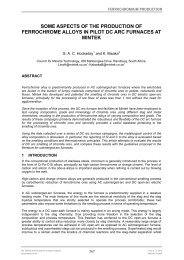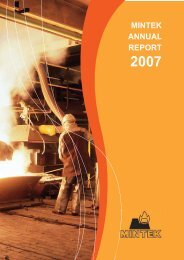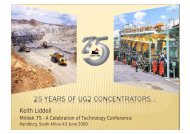<strong>Some</strong> <strong>myths</strong> <strong>about</strong> <strong>DC</strong> <strong>arc</strong> <strong>furnaces</strong>through a new one in case of an electrode breakage, suchthat practically no <strong>DC</strong> voltage increase can be seen. Althoughone second might appear as an instant to our eyes,electrically speaking this is a lot of time, representing 50 or60 entire cycles, in which control systems can take <strong>about</strong> 500corrective actions.In any case, the <strong>DC</strong> power supply should also be equippedwith over-voltage protection that shorts high-voltagetransients (e.g. from transformer energizing) to groundimmediately for protecting the thyristors.There has also been much concern <strong>about</strong> flashovers (alsoknown as stray <strong>arc</strong>ing) to the furnace shell, particularly to thefurnace roof. This is somewhat critical where the slag is veryconductive, for example TiO 2 slag, but less important in thecase of the highly resistive slags such as those found inferronickel smelting or cobalt recovery from slags. With aproper design of the furnace, correct isolation of the roof holefrom the electrode, and an optimized feeding system, aflashover does not occur.Keep in mind that, under normal circumstances, the liquidbath in the furnace is the <strong>arc</strong>’s lowest resistance (‘shortestpath’) to the rectifier’s 0 V potential through to the anode inthe furnace bottom, and hence the <strong>arc</strong> has no ‘motivation’ totake a longer route via the furnace roof.And should it still happen, for whatever reason, by ahigh-speed potential monitoring of the furnace roof and/orshell, the rectifier control could detect a flashover within20 ms and immediately take corrective action in order toprevent any damage to the furnace.However, stray <strong>arc</strong>ing is also a well-known phenomenonon AC <strong>arc</strong> <strong>furnaces</strong>, where the liquid bath needs to be keptisolated from ground, but with the difference that one cannottake very fast corrective actions without tripping thefurnace’s breaker.Myth 9: The bottom electrode has a short life and iscostly to maintainSince the invention of <strong>DC</strong> furnace technology, the bottomanode of the furnace has been considered one of the mostcritical parts. Different equipment manufacturers came outwith a variety of different anode designs. At the beginning,equipment manufacturers concentrated mainly on scrapmeltingapplications, always with a focus on the maintenancecosts and the metallurgically required lifetime. The threemain designs finally accepted on the market were the fin-typeelectrode from VAI Fuchs, the pin-type electrode from theSMS Group, and the conductive bottom electrode from ABB(which, after ABB divested its <strong>arc</strong> furnace business toConcast, was also claimed by the SMS Group). The first twoelectrode types are, without doubt, the best solution for steelmelting<strong>furnaces</strong>, taking into account the required lifetimeand cost of maintenance. For small smelting <strong>furnaces</strong>, themulti-pin type anode has proved to be a reliable solution.For industrial <strong>DC</strong> smelting processes, it can be said thatthe conductive bottom electrode provides a number ofadvantages to the process and furnace operation, and it is nolonger the ‘headache’ of <strong>DC</strong> technology as many people onceregarded it when comparing <strong>DC</strong> with AC technology. Because<strong>furnaces</strong> require very expensive refractory materials, thelifetime of the furnace is often of paramount importance. Asthe smelting process is a nearly continuous process, andthere is generally no direct contact between slag and hearth,this type of bottom electrode provides the longest lifetime forthe <strong>DC</strong> smelting operation. Depending on the use of thefurnace, today’s bottom electrodes can have a lifetime of 5 to10 years, without requiring any maintenance. Until recently,the conductive bottom hearth was protected by a patent, butis now available for public use.The conductive bottom electrode consists of a copperplatedsteel plate covered by metallized bricks. This ensuresconductivity even if local spots are covered by nonconductivematerial, and uses bricks to withstand themetallurgical impact. Another advantage of using bricks isthat the metal part of the bottom electrode requires only aircooling.Compared to other water-cooled systems, thispresents an important safety advantage.Myth 10: The <strong>DC</strong> <strong>arc</strong> furnace is a solution to allmetallurgical problems<strong>DC</strong> <strong>arc</strong> <strong>furnaces</strong> have some wonderful features. They are verygood at accommodating finely sized feed materials (becauseof the open bath), and they do not require the use of coke orchar. They allow for the treatment of feed materials with awide variety of composition (because of the extra degree offreedom coming from the relative independence of the powersupplied by the open plasma <strong>arc</strong>). They are geometricallysimple and elegant, which reduces costs associated withcomplex roof designs and uneven wear on sidewalls.However, it is important to take cognisance of the effect ofthe hot off-gas on thermal efficiency, and of the absence of aburden that could otherwise assist in capturing volatilespecies that might fume off the molten bath.<strong>DC</strong> <strong>arc</strong> <strong>furnaces</strong> have been found to be well suited toreductive smelting processes, such as those used for treatingchromite, ilmenite, and nickel laterite ores, oxidized concentrates,and slags. On the other hand, it is not so clear that <strong>DC</strong>Figure 15—Principle of the conductive bottom electrode▲672 OCTOBER 2011 VOLUME 111 The Journal of The Southern African Institute of Mining and Metallurgy
<strong>Some</strong> <strong>myths</strong> <strong>about</strong> <strong>DC</strong> <strong>arc</strong> <strong>furnaces</strong><strong>arc</strong> <strong>furnaces</strong> are well suited to pyrometallurgical processesrequiring oxidizing conditions, or those that involve agaseous intermediate such as SiO, or those that might bring alow-melting product into contact with a bottom anode. Thereis room for many types of furnace, and for wise choices to bemade with regard to the most appropriate technology for aparticular process.Conclusions<strong>DC</strong> <strong>arc</strong> furnace technology has existed since 1878, and hasbeen well proven for a number of applications. Early <strong>DC</strong> <strong>arc</strong>smelting <strong>furnaces</strong> were fed through hollow graphiteelectrodes, but it has been found that close feeding aroundthe <strong>arc</strong> has essentially the same result while saving on thecost of electrodes. The plasma <strong>arc</strong> is a highly dynamicphenomenon, with the <strong>arc</strong> moving extremely rapidly, often ina helical shape, or exhibiting chaotic irregular motion.Thermal radiation from an <strong>arc</strong> does exist, but it is oftendominated by the thermal radiation from the open uppersurface of the molten slag bath. The thrust exerted by the <strong>arc</strong>on the liquid slag is proportional to the square of the current,and this creates a depression in the slag; however, the slag isusually deeper than this depression in smelting <strong>furnaces</strong>.The electrical behaviour of a <strong>DC</strong> <strong>arc</strong> furnace may bemodelled as an <strong>arc</strong> in series with a layer of slag; the voltageis very nonlinear with respect to the current, and thebehaviour is certainly very different from that of a constantresistancedevice. <strong>DC</strong> <strong>furnaces</strong> have a number of electricaladvantages over AC <strong>furnaces</strong>, especially in the case of a weakelectrical grid. The more stable <strong>DC</strong> <strong>arc</strong> produces less flickerand harmonic current. The <strong>DC</strong> reactor stabilizes the <strong>arc</strong> bymeans of energy storage, but this can be done in such a wayas to avoid flashovers. Robust hearth designs exist thatprovide long lives for anode connections. <strong>DC</strong> <strong>arc</strong> <strong>furnaces</strong>provide a number of very significant metallurgicaladvantages, especially in being able to treat fine feedmaterials, and in not requiring the use of metallurgical coke.<strong>DC</strong> <strong>arc</strong> <strong>furnaces</strong> are not a panacea for all metallurgicalproblems, but are very well suited to a number of reductivesmelting processes. They have been applied successfully in anumber of industrial contexts, and many further applicationsare expected.AcknowledgementsThis paper is published by permission of <strong>Mintek</strong> and ABB,with the support of the National Rese<strong>arc</strong>h Foundation. Thecontributions and helpful comments of our colleagues aregratefully acknowledged.References1. English patents, No. 4208 of 1878 and No. 2110 of 1879.2. JONES, R.T., BARCZA, N.A., and CURR, T.R. Plasma developments in Africa.Second International Plasma Symposium: World progress in plasmaapplications. Organized by the Electric Power Rese<strong>arc</strong>h Institute, Centerfor Materials Production, Palo Alto, California, 9–11 February 1993.http://www.mintek.co.za/Pyromet/Files/PlasmaDev.pdf3. JONES, R.T., DENTON, G.M., REYNOLDS, Q.G., PARKER, J.A.L., and VAN TONDER,G.J.J. Recovery of cobalt from slag in a <strong>DC</strong> <strong>arc</strong> furnace at Chambishi,Zambia. Journal of the Southern African Institute of Mining andMetallurgy, vol. 102, no. 1, January/February 2002. pp. 5–9.http://www.mintek.co.za/Pyromet/Files/Chambishi.pdf4. NELSON, L.R., SULLIVAN, R., JACOBS, P., MUNNIK, E., LEWARNE, P., ROOS, E.,UYS, M.J.N., SALT, B., DE VRIES, M., MCKENNA, K., VOERMANN, N., andWASMUND, B.O. Application of a high-intensity cooling system to <strong>DC</strong>-<strong>arc</strong>furnace production of ferrocobalt at Chambishi. Journal of the SouthernAfrican Institute of Mining and Metallurgy, vol. 104, no. 9, October 2004.pp. 551–561. http://www.saimm.co.za/Journal/v104n09p551.pdf5. JONES, R.T. Towards commercialisation of <strong>Mintek</strong>’s ConRoast process forplatinum smelting, Nickel and Cobalt 2009: Advances in the Processing ofNickel. Cobalt and PGMs using Pyrometallurgical Techniques, 48thAnnual Conference of Metallurgists, Sudbury, Ontario, Canada, 23–26August 2009. pp. 159–168. http://www.mintek.co.za/Pyromet/Files/2009-ConRoast-CIM.pdf6. STENKVIST, S.-E. The properties and practical application of the high-powergraphite cathode d.c. <strong>arc</strong> plasma, Proceedings of <strong>Mintek</strong> 50,Johannesburg, South Africa, 26–30 M<strong>arc</strong>h 1984. pp. 769–775.7. REYNOLDS, Q.G., JONES, R.T., and REDDY, B.D. Mathematical and computationalmodelling of the dynamic behaviour of direct current plasma <strong>arc</strong>s.(Infacon 12, Helsinki, 6-9 June 2010). Journal of the Southern AfricanInstitute of Mining and Metallurgy, vol. 110, no. 12, December 2010. pp.733–742. http://www.saimm.co.za/Journal/v110n12p733.pdf.http://www.mintek.co.za/Pyromet/Files/2010Reynolds1.pdf8. MAECKER, H. Plasmaströmungen in Lichtbögen infolge EigenmagnetischeKompression. Zeitschrift für Physik, vol. 141, 1955. pp. 198–216.9. REYNOLDS, Q.G. and JONES, R.T. High speed photography and modelling ofdirect current plasma <strong>arc</strong>s. 29th International Congress on High-SpeedImaging and Photonics, Morioka, Japan, 20–24 September 2010.http://www.mintek.co.za/Pyromet/Files/2010Reynolds2.pdf10. SAGER, D. GRANT, D., STADLER, R., and SCHREITER, T. Low cost ferroalloyextraction in <strong>DC</strong>-<strong>arc</strong> furnace at Middelburg Ferrochrome. (Infacon 12,Helsinki, 6-9 June 2010). Journal of the Southern African Institute ofMining and Metallurgy, vol. 110, no. 12, December 2010. pp. 717–724.http://www.pyrometallurgy.co.za/InfaconXII/803-Sager.pdf.http://www.saimm.co.za/Journal/v110n12p717.pdf11. BOULOS, M.I., FAUCHAIS, P., and PFENDER, E. Thermal Plasmas:Fundamentals and Applications, vol. 1. Plenum Press, New York, 1994.12. REYNOLDS, Q.G. Thermal radiation modelling of <strong>DC</strong> smelting furnacefreeboards. Minerals Engineering, vol. 15, no. 11S1, November 2002.pp. 993–1000. http://www.mintek.co.za/Pyromet/Files/Radiation.pdf13. BOWMAN, B. Properties of <strong>arc</strong>s in <strong>DC</strong> <strong>furnaces</strong>. Proceedings of the 52ndElectric Furnace Conference, Nashville, USA, 13-16 November 1994.Warrendale, Iron and Steel Society,1995. pp. 111–120.14. CHESLAK, F.R., NICHOLLS, J.A., and SICHEL, M. Cavities formed on liquidsurfaces by impinging gaseous jets. Journal of Fluid Mechanics, vol. 36,Pt 1, 1969. pp. 55–63.15. JONES, R.T., REYNOLDS, Q.G., and ALPORT, M.J. <strong>DC</strong> <strong>arc</strong> photography andmodelling. Minerals Engineering, vol. 15, vol. 11S1, 2002. pp. 985–991.http://www.mintek.co.za/Pyromet/Files/ArcPhotoModel.pdf16. REYNOLDS, Q.G. and JONES, R.T. Semi-empirical modelling of the electricalbehaviour of <strong>DC</strong>-<strong>arc</strong> smelting <strong>furnaces</strong>. Journal of the Southern AfricanInstitute of Mining and Metallurgy, vol. 104, no. 7, July 2004.pp. 1–8. http://www.mintek.co.za/Pyromet/Files/2004Reynolds.pdf17. SAGER, D., PAI, R., STADLER, R., and TAMBE, S. Continuous success of <strong>DC</strong>EAF power supplies. AIST conference, Indianapolis, USA, 7–10 May 2007.18. SAGER, D. and HERBST, W. Advanced control for optimising melt process of<strong>DC</strong> <strong>arc</strong> <strong>furnaces</strong>. STI magazine, May 2002.◆TransactionPaperThe Journal of The Southern African Institute of Mining and Metallurgy VOLUME 111 OCTOBER 2011 673▲















